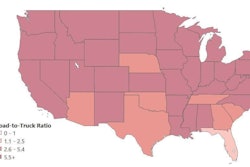Will electronic logging devices really drive up rates and driver pay? As Senior Editor Todd Dills’ story in our August issue detailed, two widely held assumptions point to capacity shortages that will push rates higher soon after the Dec. 18 mandate takes effect: 1) fewer drivers, 2) many running fewer miles.
Since then I’ve noticed far more to support that outcome than to discredit it, and it’s hardly all ELD-related. One item was the second-quarter change in driver turnover. At large truckload fleets, it jumped 16 percentage points to 90 percent for the quarter. At small fleets, it was up 19 points to 85 percent.
 This generator was being dropped at a distribution point in Bryant, Texas, after Hurricane Harvey. Hurricane recovery is one of the factors, in addition to the ELD mandate, that is expected to tighten truck capacity and push up rates. (photo by Federal Emergency Management Agency)
This generator was being dropped at a distribution point in Bryant, Texas, after Hurricane Harvey. Hurricane recovery is one of the factors, in addition to the ELD mandate, that is expected to tighten truck capacity and push up rates. (photo by Federal Emergency Management Agency)“We may be seeing the beginnings of a significant tightening of the driver market,” says Bob Costello, chief economist for the American Trucking Associations, which issued the report.
It seems that is borne out by an apparent increase in sign-on bonuses, based on the many press releases that come our way. Last month, for example, Roehl Transport offered a qualified $10,000 sign-on bonus.
This week Dills also reported on high spot market rates and record volume.
In 2016, some observers forecast a steady climb in rates, assuming a steady adoption of ELDs, which didn’t happen. Virtually none occurred with the smallest fleets.

During this month’s FTR Transportation Conference, trucking economist Noel Perry said only about 40 percent of the industry has adopted ELDs, reported News Editor James Jaillet. Perry predicted ELD adoption will cause an industry-wide productivity loss of 2.5 percent.
That’s on par with what some large fleets have reported in recent years. Small independents who’ve played loose with logging, though, might see a bigger hit as they adjust to a system that leaves little wiggle room.
How hard will the transition hit the holdouts? Also at the FTR meeting, Prime Inc. VP Steve Wutke predicted a productivity loss of 4-7 percent. And speaking of procrastinators and capacity, no one really know how many small fleets or drivers will fulfill promises to leave the industry by Dec. 18.
FTR’s Jonathan Starks notes the effect of these reductions in capacity and productivity, combined with double-digit increases in spot rates, “a slightly more robust economy” and a spike from hurricane recovery shipping.
“That’s a market which gives fleets a reason to be optimistic,” he says.
The same can be said for owner-operators prepared to run on through the transition.
Don’t expect a cataclysm of empty grocery shelves and sky-high rates, as has been hyped prior to other major industry changes. But these factors indeed point to a capacity crunch – Perry predicts it happening between March and July – that clearly exceeds the market’s typical ups and downs.
Are you noticing tighter capacity in the spot market? Comment below.













